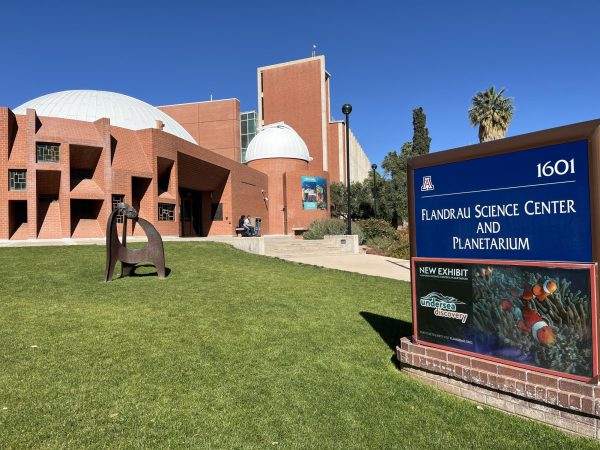The Apollo missions to the moon. The Viking missions to Mars. The Voyager missions to deep space. These are a series of what one might call “small steps for man” that have one surprising thing in common: the University of Arizona was involved.
Since 1964, the UA has been part of every NASA planetary mission. However, the relationship between the two predates even the moon landing.
The UA’s Lunar and Planetary Laboratory was founded in 1960 by Gerard Kuiper, as the infamous Space Race between the US and the USSR was heating up.
RELATED: Q&A with Gordon W. Downs: Mars Science Laboratory Team member
By 1964, the Ranger 6 mission, the first NASA mission the UA was involved with, had successfully landed on the moon. However, it did not achieve its goal of transmitting high-resolution photographs of the lunar surface, as there was a failure of the camera system.
Later Ranger missions, like Ranger 7, were more successful in transmitting footage of the lunar surface back to a scientist on Earth. Kuiper, for whom the Kuiper Belt is named, was the principal investigator on Ranger 7.
Kuiper, along with Ewen Whitaker, a fellow astronomer who came with Kuiper to UA in 1960, worked on the 1966 Surveyor 1 mission, which proved that larger spacecraft could safely land on the moon. Before that mission, it was unknown if the lunar surface was too soft, or if the spacecraft would sink.
By 1968, history was on the horizon. NASA’s first successful manned lunar orbit Apollo mission, Apollo 8, launched in December of that year with a crew of three.
Robert Strom, a retired professor emeritus in the UA Lunar and Planetary Lab, was on the lunar operations working groups for Apollo missions 8, 10 and the immortal 11 — when man first walked on the moon.
After the moon landing, there was nowhere to go but farther into space.
Starting between 1972 and 1973, Pioneer missions 10 and 11 would provide NASA with some of its first spacecraft-gathered data for planetary exploration.
Images from the Pioneer spacecraft would reach Earth thanks to equipment built by Tom Gehrels, an astronomer with the Lunar Planetary Lab who worked at UA for over 50 years.
UA also had a hand in later Voyager missions in 1979 that would venture deeper out into space, as far out as any man-made spacecraft had before.
Both Voyager 1 and 2 are still exploring space, carrying the Golden Records that contain carefully selected sounds and images showcasing what life is like on Earth.
In our own solar system, humans have sent spacecraft to explore nearly all the planets, though Uranus and Neptune have only been briefly studied by Voyager 2.
The UA aided NASA in its missions to reach the orbit of Mercury in the MESSENGER mission and the orbit of Venus which launched in 2004 in the 1978 Pioneer Venus mission.
Farther into space, the 1989 Galileo mission studied Jupiter and its moons, the 1990 Ulysses mission studied the Sun at close range and the 1997 Cassini mission studied Saturn, all with the involvement of UA scientists.
The Europa mission, which is planned to launch as early as 2022 to explore Jupiter’s moon Europa, may also feature involvement from the UA.
“I’m proposing a camera system for a Europa mission now that builds off UA’s past history,” said Shane Byrne, assistant head of the planetary science department and professor in the Lunar and Planetary Laboratory. “I think our history is a huge asset.”
UA has also been heavily involved with the exploration of our neighboring planet Mars.
Mankind first reached Mars via unmanned rover in 1976 when the Viking 1 spacecraft landed on the Chryse Planitia, or Gold Plains, of the red planet. By that point, Viking had already sent back multiple high-resolution photos.
UA’s own Brad Smith, who had also worked on the Voyager missions, led the Viking imaging team. In 1986, while working on Voyager, he would discover Bianca, a moon orbiting Uranus.
The UA would continue to be a part of mankind’s exploration of Mars, playing key parts in the 1996 Mars Pathfinder Mission, 2001 Mars Odyssey Mission and the 2007 Phoenix Mars Lander Mission, which was the first ever university-led mission to the red planet.
Looking at the present, future and beyond, the University of Arizona is continuing its history of space exploration and is currently a key player in NASA’s OSIRIS-REx mission.
OSIRIS-REx launched on Sept. 8, 2016, with the mission to acquire a small sample from the near-earth asteroid Bennu and bring it back to Earth for further study.
RELATED: From STEM to flower: Science City brings public-friendly science to the Festival of Books
In August of this year, OSIRIS-REx captured its first images of Bennu. It is set to acquire the sample in 2020 and return to Earth in 2023, when, if successful, it will make history as the first U.S. spacecraft to return samples from an asteroid.
“I am very proud of UA’s history in supporting NASA planetary exploration and space science,” said Dante Lauretta, principal investigator on the OSIRIS-REx mission and a professor of planetary science an cosmochemistry at UA. “It is certainly a factor in my ongoing activities, such as leading the OSIRIS-REx mission.”
As of 2016, UA is the eighth highest funded institution of higher education for research and development by NASA, beating out universities like Harvard and Stanford.
Timeline:
Follow Vanessa Ontiveros and Sharon Essien on Twitter















